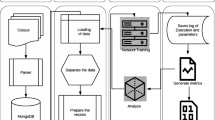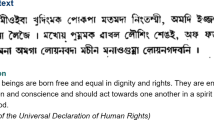Abstract
Natural language processing (NLP) is the technology that enables machine to process human language. Entity recognition is one of the most basic tasks in NLP. It aims to identify and classify the name of each object in the text. Traditional named entity recognition systems can only identify a small set of types such as person, location, organization or miscellaneous. In order to make machine exploit the meaning of the text better, it is necessary to classify the entities appearing in the text to fine-grained types. Previously reported work generally obtained the entity context information through a fixed window, so the external information for classifying the entity is not enough, which may lead to ambiguity. To solve the shortcomings of these methods, this paper presents a fine-grained entity type classification method for unstructured text based on global information and sliding window context. By combining those information with other features, we utilize a bidirectional long–short-term memory network to perform the classification work. With the proposed method, the experiment results of fine-grained entity type classification are optimized.









Similar content being viewed by others
References
Barua J, Patel D (2017) Named entity classification using search engine’s query suggestions. In: European conference on information retrieval, pp 612–618
Blei DM, Ng AY, Jordan MI (2003) Latent dirichlet allocation. J Mach Learn Res 3(1):993–1022
Brown PF, Desouza PV, Mercer RL, Pietra VJD, Lai JC (1992) Class-based n-gram models of natural language. Comput Linguist 18(4):467–479
Corro LD, Abujabal A, Gemulla R, Weikum G (2015) FINET: context-aware fine-grained named entity typing. In: Conference on empirical methods in natural language processing, pp 868–878
Cui KY, Ren PJ, Chen ZM, Lian T, Ma J (2017) Relation enhanced neural model for type classification of entity mentions with a fine-grained taxonomy. J Comput Sci Technol 32(4):814–827
Dan G, Lazic N, Ganchev K, Kirchner J, Huynh D (2016) Context-dependent fine-grained entity type tagging. arXiv preprint arXiv:1412.1820, 2014
Dong L, Wei F, Sun H, Zhou M, Xu K (2015) A hybrid neural model for type classification of entity mentions. In: International conference on artificial intelligence, pp 1243–1249
Fleischman M, Hovy E (2002) Fine grained classification of named entities. In: Proceeding of the 19th international conference on computational linguistics, pp 1–7
Giuliano C, Gliozzo A (2008) Instance-based ontology population exploiting named-entity substitution, COLING 2008. In: Proceeding of the 22th international conference on computational linguistics, Manchester, UK, pp 265–272
Gotti F, Langlais P (2016) Harnessing open information extraction for entity classification in a French corpus. In: Canadian conference on artificial intelligence, pp 150–161
Graves A (2012) Supervised sequence labelling. In: Supervised sequence labelling with recurrent neural networks. Studies in computational intelligence, vol 385. Springer, Berlin, Heidelberg
Hoffart J, Suchanek FM, Berberich K, Weikum G (2013) Yago2: a spatially and temporally enhanced knowledge base from wikipedia. Artif Intell 194(1):28–61
Kingma DP, Ba J (2015) Adam: a method for stochastic optimization. In: The 3rd international conference for learning representations, San Diego. arXiv:1412.6980
Kleinberg JM (1999) Authoritative sources in a hyperlinked environment. J ACM 46(5):604–632
Krupka GR, Hausman K (1998) Isoquest inc.: description of the netowl\(^{{\rm tm}}\) extractor system as used for muc-7. In: Proceedings of MUC, vol 7
Lee C, Hwang YG, Oh HJ, Lim S, Heo J, Lee CH et al (2006) Fine-grained named entity recognition using conditional random fields for question answering. In: Proceeding of third Asia information retrieval symposium, pp 581–587
Mintz M, Bills S, Snow R, Dan J (2009) Distant supervision for relation extraction without labeled data. In: Proceedings of the joint conference of the 47th annual meeting of the ACL and the 4th international joint conference on natural language processing of the AFNLP, vol 2, pp 1003–1011
Pennington J, Socher R, Manning C (2014) Glove: global vectors for word representation. In: Proceedings of the 2014 conference on empirical methods in natural language processing (EMNLP), pp 1532–1543
Rahman A, Ng V (2010) Inducing fine-grained semantic classes via hierarchical and collective classification. In: Proceedings of the 23rd international conference on computational linguistics, pp 931–939
Ren X, He W, Qu M, Voss CR, Ji H, Han J (2016) Label noise reduction in entity typing by heterogeneous partial-label embedding: arXiv: 1602.05307
Sang EFTK, Meulder FD (2003) Introduction to the conll-2003 shared task: language-independent named entity recognition. In: Proceedings of the seventh conference on Natural language learning at HLT-NAACL 2003, vol 4, pp 142–147
Sekine S (2009) Extended named entity ontology with attribute information. In: Proceeding of international conference on language resources and evaluation, Lrec 2008, 26 May–1 June 2008, Marrakech, Morocco, vol 24, pp 52–57
Shimaoka S, Stenetorp P, Inui K, Riedel S (2016) An attentive neural architecture for fine-grained entity type classification. arXiv preprint arXiv:1604.05525
Shimaoka S, Stenetorp P, Inui K, Riedel S (2017) Neural architectures for fine-grained entity type classification. arXiv preprint arXiv:1606.01341
Singh PK, Kumar C (2015) A note on computing the crisp order context of a fuzzy formal context for knowledge reduction. J Inf Process Syst 11(2):184–204
Vijayarajan V, Dinakaran M, Tejaswin P, Lohani M (2016) A generic framework for ontology-based information retrieval and image retrieval in web data. Human Centric Comput Inf Sci 6(1):18
Viswanathan V, Krishnamurthi I (2012) Finding relevant semantic association paths through user-specific intermediate entities. Human Centric Comput Inf Sci 2(1):1–11
Xiao L, Weld DS (2012a) Entity linking with a knowledge base: issues, techniques, and solutions. IEEE Trans Knowl Data Eng 27(2):443–460
Xiao L, Weld DS (2012b) Fine-grained entity recognition. In: Proceedings of the 26th conference on artificial intelligence (AAAI)
Yogatama D, Gillick D, Lazic N (2015) Embedding methods for fine grained entity type classification. In: Meeting of the association for computational linguistics and the international joint conference on natural language processing, pp 291–296
Yosef MA, Bauer S, Hoffart J, Spaniol M, Weikum G (2015) HYENA: hierarchical type classification for entity names. In: Processing of COLING 2012: posters, pp 1361–1370
Acknowledgements
This work was supported by Shanghai Maritime University research fund project (20130469), Shanghai Science & Technology Innovation Plan Fund (14511107400), the State Oceanic Administration China research fund project (201305026), and by the open research fund of Key Lab of Broadband Wireless Communication and Sensor Network Technology (Nanjing University of Posts and Telecommunications), Ministry of Education. This work was also supported by the Industrial Core Technology Development Program (10049079, Development of Mining core technology exploiting personal big data) funded by the Ministry of Trade, Industry and Energy (MOTIE), Korea.
Author information
Authors and Affiliations
Corresponding author
Ethics declarations
Conflict of interest
The authors declare that he has no conflict of interest.
Ethical approval
This article does not contain any studies with human participants performed by any of the authors.
Additional information
Communicated by J. Park.
Rights and permissions
About this article
Cite this article
Liu, J., Wang, L., Zhou, M. et al. Fine-grained entity type classification with adaptive context. Soft Comput 22, 4307–4318 (2018). https://doi.org/10.1007/s00500-017-2963-2
Published:
Issue Date:
DOI: https://doi.org/10.1007/s00500-017-2963-2




